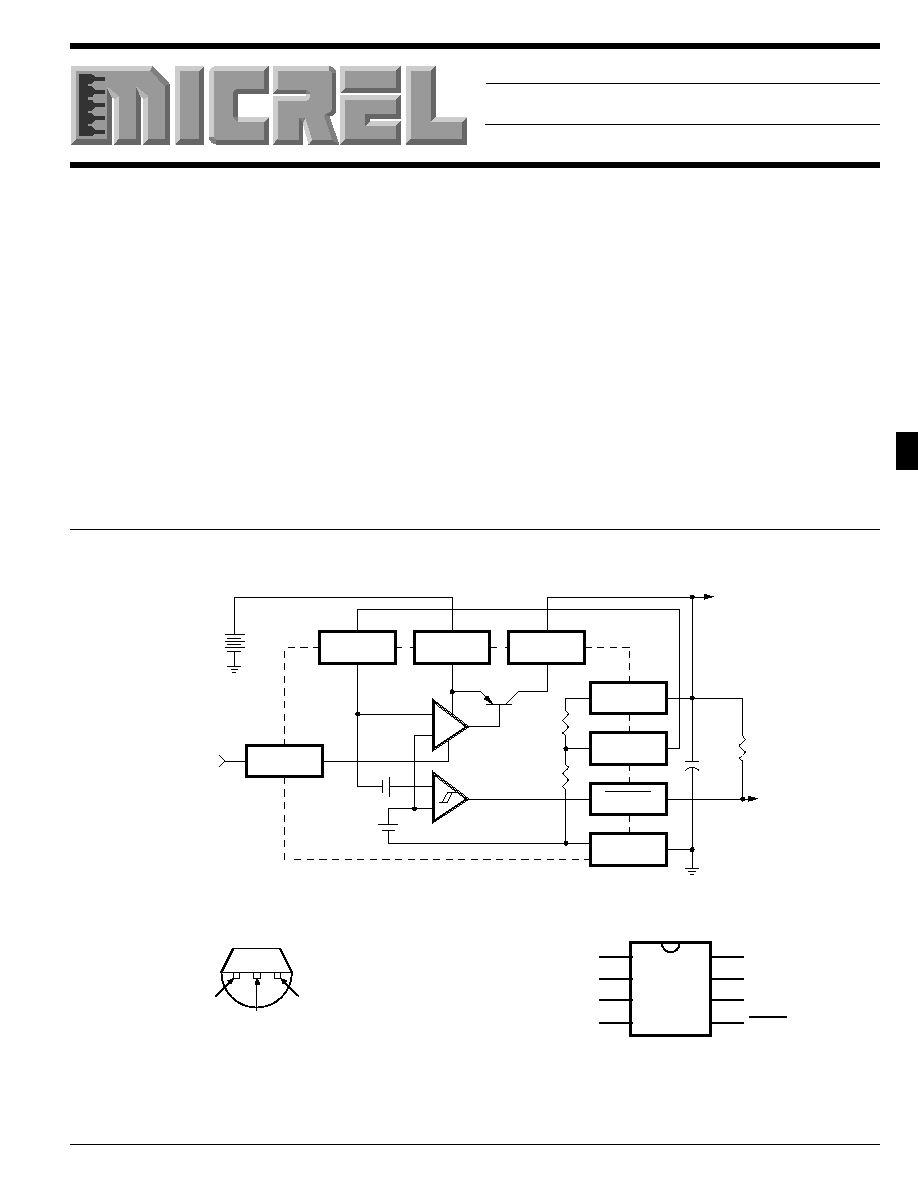
LP2950/2951
Micrel
3
February 1999
3-35
LP2950/2951
100mA Low-Dropout Voltage Regulator
General Description
The LP2950 and LP2951 are micropower voltage regulators
with very low dropout voltage (typically 40mV at light loads
and 380mV at 100mA), and very low quiescent current (75
µ
A
typical). The quiescent current of the LP2950/LP2951
increases only slightly in dropout, thus prolonging battery life.
This feature, among others, makes the LP2950 and LP2951
ideally suited for use in battery-powered systems.
Available in a 3-Pin TO-92 package, the LP2950 is pin-
compatible with the older 5V regulators. Additional system
functions, such as programmable output voltage and logic-
controlled shutdown, are available in the 8-pin DIP and 8-pin
SOIC versions of the LP2951.
Features
∑
High accuracy 5V, guaranteed 100 mA output
∑
Extremely low quiescent current
∑
Low-dropout voltage
∑
Extremely tight load and line regulation
∑
Very low temperature coefficient
∑
Use as regulator or reference
∑
Needs only 1
µ
F for stability
∑
Current and thermal limiting
LP2951 Versions Only
∑
Error flag warns of output dropout
∑
Logic-controlled electronic shutdown
∑
Output programmable from 1.24 to 29V
Block Diagram and Pin Configurations
LP2950 and LP2951 Block Diagram
(Pin Numbers Refer to LP2951)
1
2
3
4
8
7
6
5
OUTPUT
SENSE
SHUTDOWN
GROUND
ERROR
5V TAP
FEEDBACK
INPUT
GROUND
OUTPUT
INPUT
TO-92 Plastic Package Bottom View
(BZ)
DIP and SO Packages
(BN and BM)
Applications
∑
Automotive Electronics
∑
Voltage Reference
∑
Avionics
3 2
1
See MIC2950 for a part with 1) higher output (150 mA), 2) transient protection (60V), and 3) reverse input protection to ≠20V)
5V TAP
6
SENSE
2
GROUND
4
ERROR
5
TO CMOS
OR TTL
330
k
+
1.5 µF
60
k
182
k
OUTPUT
INPUT
FEEDBACK
1
8
7
5V
150 mA
MAX.
+
≠
+
≠
ERROR
AMPLIFIER
ERROR
DETECTION
COMPARATOR
+
1.23 V
REF.
+
60 mV
SHUT-
DOWN
3
FROM
CMOS
OR TTL
+
UNREGULATED DC

LP2950/2951
Micrel
3-36
February 1999
Additional features available with the LP2951 also include an
error flag output that warns of a low output voltage, which is
often due to failing batteries on the input. This may also be
used as a power-on reset. A logic-compatible shutdown input
is also available which enables the regulator to be switched on
and off. This part may also be pin-strapped for a 5V output,
or programmed from 1.24V to 29V with the use of two external
resistors.
The LP2950 is available as either an -02 or -03 version. The
-02 and -03 versions are guaranteed for junction temperatures
from ≠40
∞
C to +125
∞
C; the -02 version has a tighter output and
reference voltage specification range over temperature. The
LP2951 is available as an -02 or -03 version.
The LP2950 and LP2951 have a tight initial tolerance (0.5%
typical), a very low output voltage temperature coefficient
which allows use as a low-power voltage reference, and
extremely good load and line regulation (0.05% typical). This
greatly reduces the error in the overall circuit, and is the result
of careful design techniques and process control.
Absolute Maximum Ratings
If Military/Aerospace specified devices are required, contact your local
Micrel representative/distributor for availability and specifications.
Power dissipation
Internally Limited
Lead Temperature (Soldering, 5 seconds)
260
∞
C
Storage Temperature Range
≠65
∞
C to +150
∞
C
Operating Junction Temperature Range (Note 8)
LP2950, LP2951
≠40
∞
C to +125
∞
C
Input Supply Voltage
≠0.3V to +30V
Feedback Input Voltage (Notes 9 and 10)
≠1.5V to +30V
Shutdown Input Voltage (Note 9)
≠0.3V to +30V
Error Comparator Output Voltage (Note 9)
≠0.3V to +30V
ESD Rating is to be determined.
Ordering Information
Part Number
Voltage
Temperature Range*
Package
Accuracy
LP2950-02BZ
5.0V
≠40
∞
C to +125
∞
C
3-Pin TO-92 plastic
0.5%
LP2950-03BZ
5.0V
≠40
∞
C to +125
∞
C
3-Pin TO-92 plastic
1.0%
LP2951-02BM
5.0V
≠40
∞
C to +125
∞
C
8-Pin SOIC
0.5%
LP2951-03BM
5.0V
≠40
∞
C to +125
∞
C
8-Pin SOIC
1.0%
LP2951-02BN
5.0V
≠40
∞
C to +125
∞
C
8-Pin Plastic DIP
0.5%
LP2951-03BN
5.0V
≠40
∞
C to +125
∞
C
8-Pin Plastic DIP
1.0%
LP2951-4.8BM
4.85V
≠40
∞
C to +125
∞
C
8-Pin SOIC
1.0%
* Junction temperatures
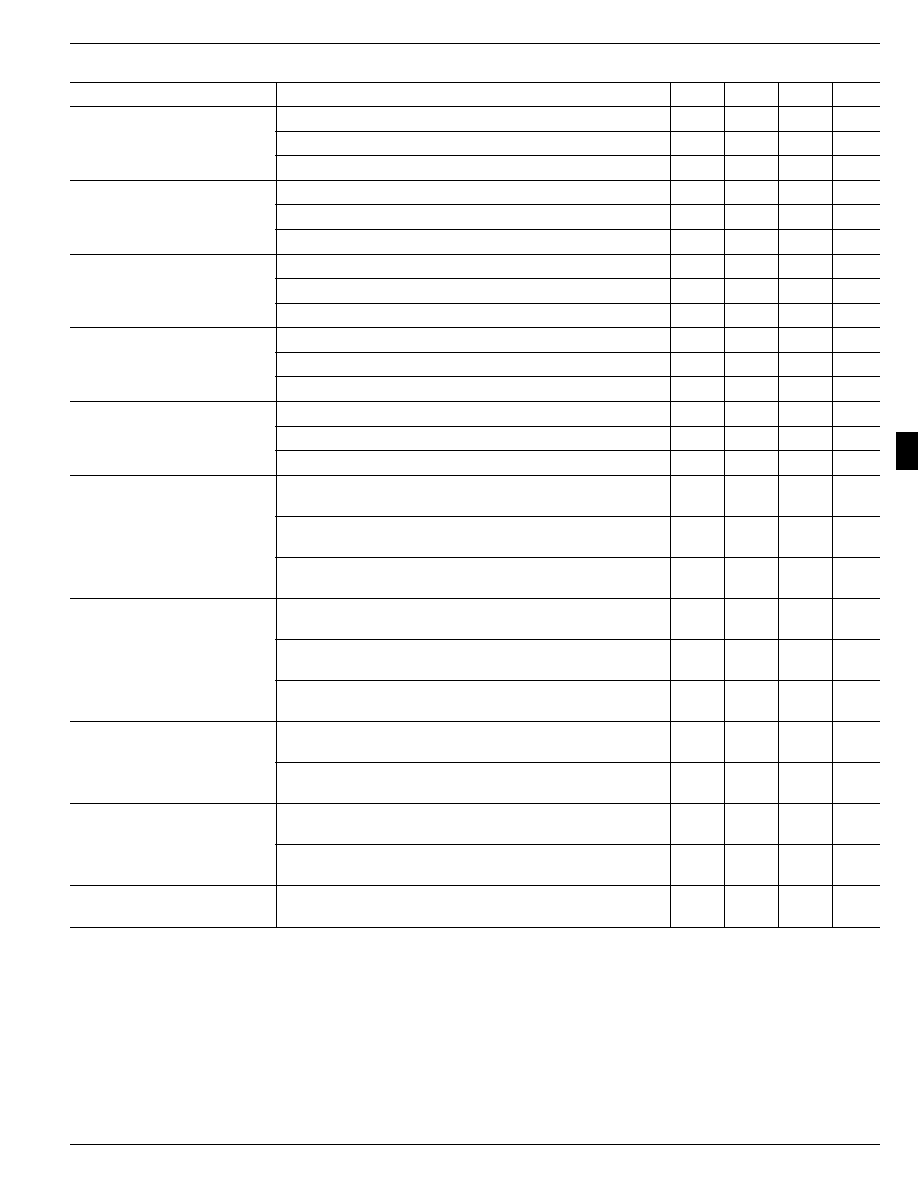
LP2950/2951
Micrel
3
February 1999
3-37
Electrical Characteristics
Note 1 T
A
= 25
∞
C except as noted.
Parameter
Condition
Min
Typ
Max
Units
Output Voltage
LP295x-02 (
±
0.5%)
4.975
5.000
5.025
V
T
J
= 25
∞
C
LP295x-03 (
±
1%)
4.950
5.000
5.050
V
LP2951-4.8 (
±
1%)
4.802
4.850
4.899
V
Output Voltage
LP295x-02 (
±
0.5%)
4.950
5.050
V
≠25
∞
C
T
J
+85
∞
C
LP295x-03 (
±
1%)
4.925
5.075
V
LP2951-4.8 (
±
1%)
4.777
4.872
V
Output Voltage
LP295x-02 (
±
0.5%), ≠40
∞
C to +125
∞
C
4.940
5.060
V
Over Full Temperature Range
LP295x-03 (
±
1%), ≠40
∞
C to +125
∞
C
4.900
5.100
V
LP2951-4.8 (
±
1%), ≠40
∞
C to +125
∞
C
4.753
4.947
V
Output Voltage
LP295x-02 (
±
0.5%), 100
µ
A
I
L
100mA, T
J
T
J(max)
4.930
5.070
V
Over Load Variation
LP295x-03 (
±
1%), 100
µ
A
I
L
100mA, T
J
T
J(max)
4.880
5.120
V
LP2951-4.8 (
±
1%), 100
µ
A
I
L
100mA, T
J
T
J(max)
4.733
4.967
V
Output Voltage
LP295x-02 (
±
0.5%), Note 12
20
100
ppm/
∞
C
Temperature Coefficient
LP295x-03 (
±
1%), Note 12
50
150
ppm/
∞
C
LP2951-4.8 (
±
1%), Note 12
50
150
ppm/
∞
C
Line Regulation
LP295x-02 (
±
0.5%), Notes 14, 15
0.03
0.10
%
0.20
%
LP295x-03 (
±
1%), Notes 14, 15
0.04
0.20
%
0.40
%
LP2951-4.8 (
±
1%), Notes 14, 15
0.04
0.20
%
0.40
%
Load Regulation
LP295x-02 (
±
0.5%), Note 14, 100
µ
A
I
L
100mA
0.04
0.10
%
0.20
%
LP295x-03 (
±
1%), Note 14, 100
µ
A
I
L
100mA
0.10
0.20
%
0.30
%
LP2951-4.8 (
±
1%), Note 14, 100
µ
A
I
L
100mA
0.10
0.20
%
0.30
%
Dropout Voltage
Note 5, I
L
= 100
µ
A
50
80
mV
150
mV
Note 5, I
L
= 100mA
380
450
mV
600
mV
Ground Current
I
L
= 100
µ
A
100
150
µ
A
200
µ
A
I
L
= 100mA
8
12
mA
14
mA
Dropout Current
V
IN
= 4.5V, I
L
= 100
µ
A
180
250
µ
A
310
µ
A
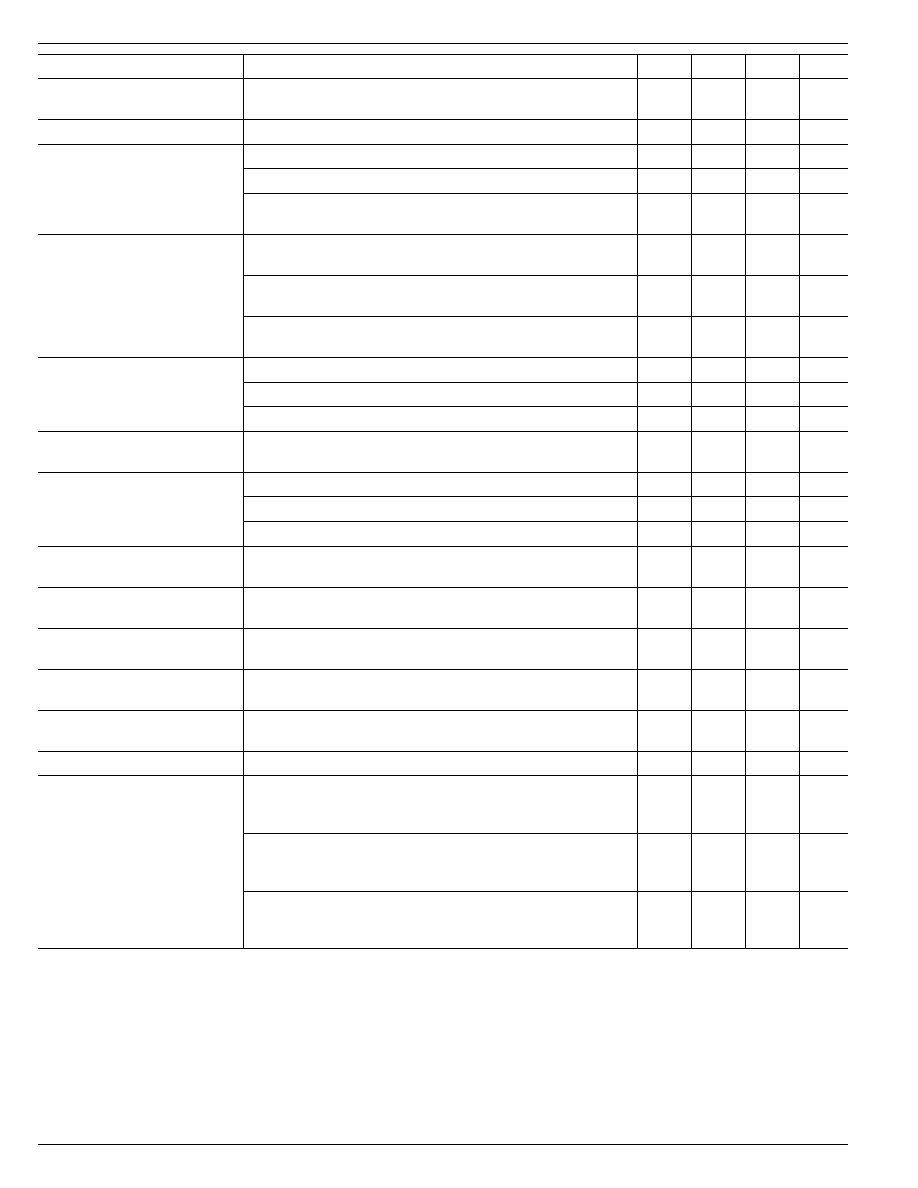
LP2950/2951
Micrel
3-38
February 1999
Parameter
Condition
Min
Typ
Max
Units
Current Limit
V
OUT
= 0V
160
200
mA
220
mA
Thermal Regulation
Note 13
0.05
0.20
%/W
Output Noise
10Hz to 100kHz, C
L
= 1
µ
F
430
µ
V
RMS
10Hz to 100kHz, C
L
= 200
µ
F
160
µ
V
RMS
10Hz to 100kHz, C
L
= 3.3
µ
F,
100
µ
V
RMS
0.01
µ
F bypass Feedback to Output
Reference Voltage
LP295x-02 (
±
0.5%)
1.220
1.235
1.250
V
1.200
1.260
V
LP295x-03 (
±
1%)
1.210
1.235
1.260
V
1.200
1.270
V
LP2951-4.8 (
±
1%)
1.210
1.235
1.260
V
1.200
1.270
V
Reference Voltage
LP295x-02 (
±
0.5%), Note 7
1.190
1.270
V
LP295x-03 (
±
1%), Note 7
1.185
1.285
V
LP2951-4.8 (
±
1%), Note 7
1.185
1.285
V
Feedback Bias Current
20
40
nA
60
nA
Reference Voltage
LP295x-02 (
±
0.5%), Note 12
20
ppm/
∞
C
LP295x-03 (
±
1%), Note 12
50
ppm/
∞
C
LP2951-4.8 (
±
1%), Note 12
50
ppm/
∞
C
Feedback Bias Current
0.1
nA/
∞
C
Temperature Coefficient
Output Leakage Current
V
OH
= 30V
0.01
1.00
µ
A
2.00
µ
A
Output Low Voltage (Flag)
V
IN
= 4.5V, I
OL
= 200
µ
A
150
250
mV
400
mV
Upper Threshold Voltage
Note 6
40
60
mV
25
mV
Lower Threshold Voltage
Note 6
75
95
mV
140
mV
Hysteresis
Note 6
15
mV
Input Logic Voltage
LP295x-02 (
±
0.5%)
1.3
V
Low
0.7
V
High
2.0
V
LP295x-03 (
±
1%)
1.3
V
Low
0.7
V
High
2.0
V
LP2951-4.8 (
±
1%)
1.3
V
Low
0.7
V
High
2.0
V
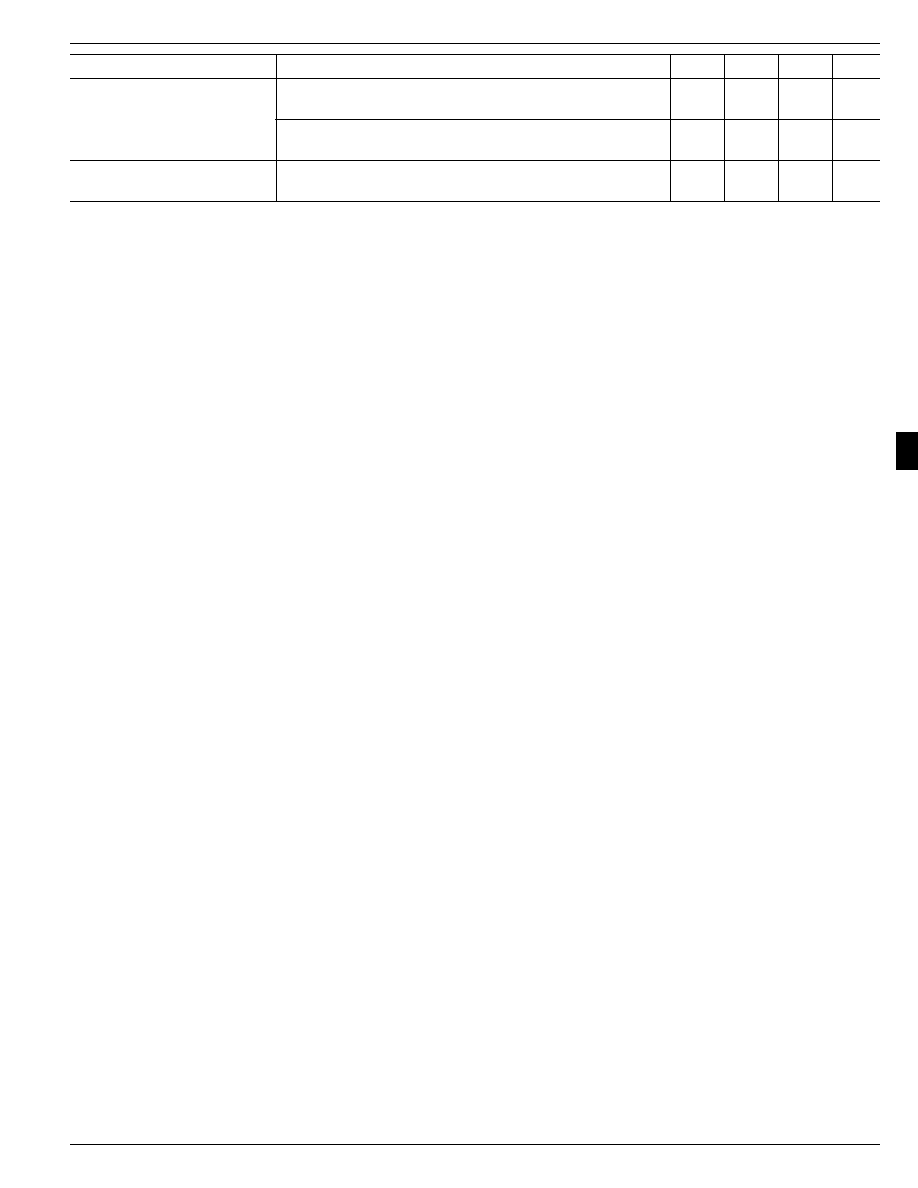
LP2950/2951
Micrel
3
February 1999
3-39
Parameter
Condition
Min
Typ
Max
Units
Shutdown Input Current
V
SHUTDOWN
= 2.4V
30
50
µ
A
100
µ
A
V
SHUTDOWN
= 30V
450
600
µ
A
750
µ
A
Regulator Output Current
Note 11
3
10
µ
A
in Shutdown
20
µ
A
Note 1:
Boldface limits apply at temperature extremes.
Note 2:
Unless otherwise specified all limits guaranteed for T
J
= 25
∞
C, V
IN
= 6V, I
L
= 100
µ
A and C
L
= 1
µ
F. Additional conditions for the 8-pin versions
are Feedback tied to 5V Tap and Output tied to Output Sense (V
OUT
= 5V) and V
SHUTDOWN
0.8V.
Note 3:
Guaranteed and 100% production tested.
Note 4:
Guaranteed but not 100% production tested. These limits are not used to calculate outgoing AQL levels.
Note 5:
Dropout voltage is defined as the input to output differential at which the output voltage drops 100mV below its nominal value measured at 1V
differential. At very low values of programmed output voltage, the minimum input supply voltage of 2V (2.3V over temperature) must be taken
into account.
Note 6:
Comparator thresholds are expressed in terms of a voltage differential at the Feedback terminal below the nominal reference voltage
measured at 6V input. To express these thresholds in terms of output voltage change, multiply by the error amplifier gain = V
OUT
/V
REF
=
(R1 + R2)/R2. For example, at a programmed output voltage of 5V, the Error output is guaranteed to go low when the output drops by
95mV x 5V/1.235V = 384mV. Thresholds remain constant as a percent of V
OUT
as V
OUT
is varied, with the dropout warning occurring at
typically 5% below nominal, 7.5% guaranteed.
Note 7:
V
REF
V
OUT
(V
IN
≠ 1 V), 2.3V
V
IN
30V, 100
µ
A < I
L
100mA, T
J
T
JMAX
.
Note 8:
The junction-to-ambient thermal resistance of the TO-92 package is 180
∞
C/W with 0.4" leads and 160
∞
C/W with 0.25" leads to a PC board.
The thermal resistance of the 8-pin DIP package is 105
∞
C/W junction-to-ambient when soldered directly to a PC board. Junction-to-ambient
thermal resistance for the SOIC (M) package is 160
∞
C/W.
Note 9:
May exceed input supply voltage.
Note 10: When used in dual-supply systems where the output terminal sees loads returned to a negative supply, the output voltage should be diode-
clamped to ground.
Note 11: V
SHUTDOWN
2V, V
IN
30 V, V
OUT
= 0, with Feedback pin tied to 5V Tap.
Note 12: Output or reference voltage temperature coefficient is defined as the worst case voltage change divided by the total temperature range.
Note 13: Thermal regulation is defined as the change in output voltage at a time T after a change in power dissipation is applied, excluding load or line
regulation effects. Specifications are for a 50mA load pulse at V
IN
= 30V (1.25W pulse) for t = 10ms.
Note 14: Regulation is measured at constant junction temperature, using pulse testing with a low duty cycle. Changes in output voltage due to heating
effects are covered in the specification for thermal regulation.
Note 15: Line regulation for the LP2951 is tested at 150
∞
C for I
L
= 1mA. For I
L
= 100
µ
A and T
J
= 125
∞
C, line regulation is guaranteed by design to
0.2%. See Typical Performance Characteristics for line regulation versus temperature and load current.
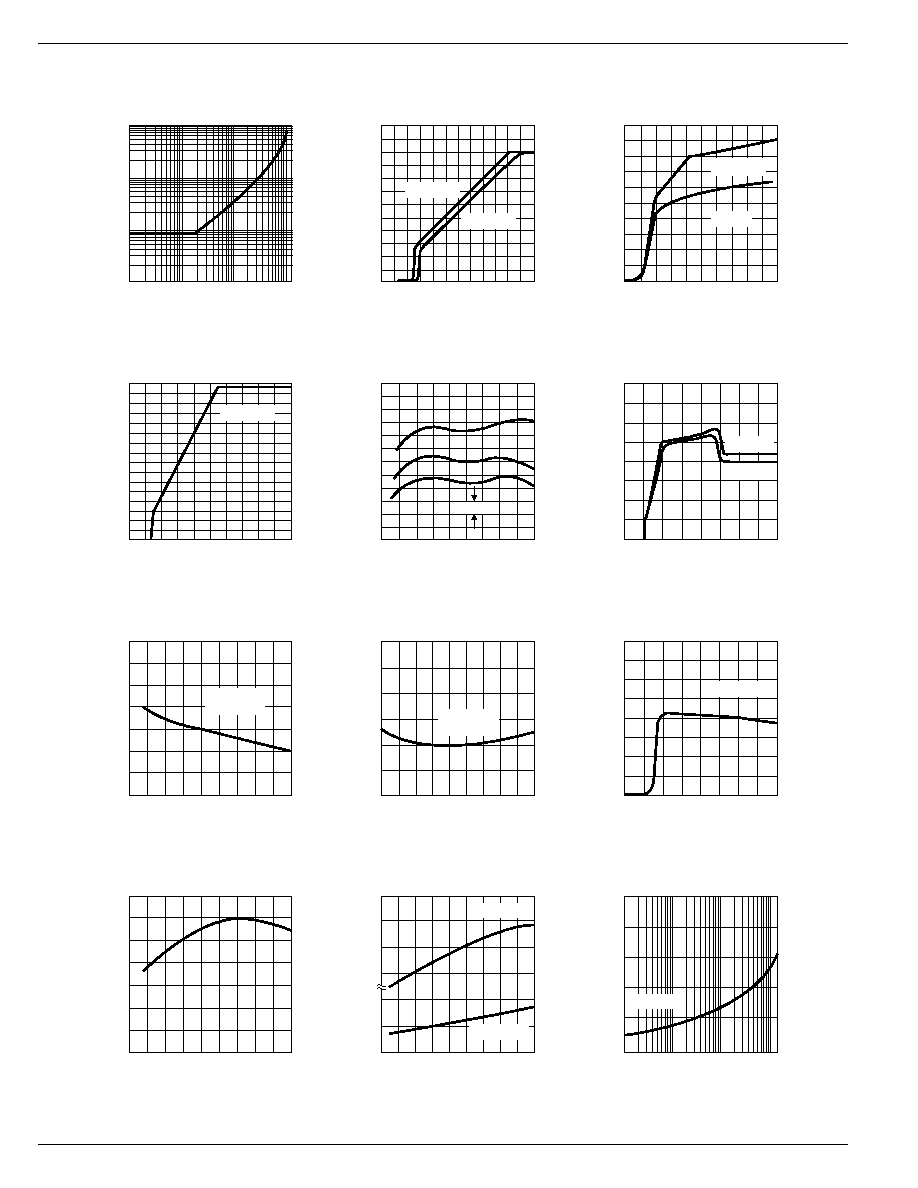
LP2950/2951
Micrel
3-40
February 1999
Typical Performance Characteristics
Quiescent Current
Dropout Characteristics
Ground Current
Output Voltage vs.
Temperature of 3
Representative Units
Input Current
Ground Current
Ground Current
Quiescent Current
Drop-out Voltage
Short Circuit Current
Drop-out Voltage
0.1
1
10
150
10
1
0.1
0.01
0
1
2
3
4
5
6
1
2
3
4
5
6
0
120
110
100
90
80
70
60
50
40
30
20
10
0
0
1
2
3
4
5
6 7
8
9 10
5.06
5.04
5.02
5.0
4.98
4.96
4.94
-75 -50 -25 0 25 50 75 100 125 150
0
40
80
120
160
200
240
280
320
0
1
2
3
4
5
6
7
8
240
220
200
180
-75 -50 -25 0 25 50 75 100 125 150
16
12
8
4
-75 -50 -25 0 25 50 75 100 125 150
16
14
12
10
8
6
4
2
0
0
1
2
3
4
5
6
7
8
170
160
150
140
130
120
110
100
-75 -50 -25 0 25 50 75 100 125 150
600
500
400
300
100
50
0
-75 -50 -25 0 25 50 75 100 125 150
500
400
300
200
100
0
100 µA
1 mA
10 mA
100 mA
R = 50k
L
R = 50
L
0.2%
I = 1 mA
L
I = 0
L
V = 6V
I = 100 µA
IN
L
V = 6V
I = 100 mA
IN
L
I = 100 mA
L
I = 100 mA
L
I = 100 µA
L
T = 25 ∞C
J
LOAD CURRENT (mA)
INPUT VOLTAGE (VOLTS)
INPUT VOLTAGE (VOLTS)
TEMPERATURE (∞C)
INPUT VOLTAGE (VOLTS)
TEMPERATURE (∞C)
TEMPERATURE (∞C)
INPUT VOLTAGE (V)
TEMPERATURE (∞C)
TEMPERATURE (∞C)
OUTPUT CURRENT
GROUND PIN CURRENT (mA)
OUTPUT VOLTAGE (VOLTS)
INPUT CURRENT (mA)
OUTPUT VOLTAGE (V)
GROUND CURRENT (µA)
QUIESCENT CURRENT (µA)
GROUND CURRENT (mA)
GROUND CURRENT (mA)
SHORT CIRCUIT CURRENT (mA)
DROP-OUT VOLTAGE (mV)
DROP-OUT VOLTAGE (mV)
130
140
150
160
Input Current
0
25
50
75
100
125
150
175
200
225
250
0
1 2
3 4
5 6
7 8 9 10
R = 50k
L
R =
L
INPUT VOLTAGE (VOLTS)
INPUT CURRENT (µA)
R = 50
L

LP2950/2951
Micrel
3
February 1999
3-41
LP2951
Error Comparator Output
LP2951
Minimum Operating Voltage
Line Transient Response
Load Transient Response
Load Transient Response
Ripple Rejection
Output Impedance
2.2
2.0
1.9
1.6
-30
-20
-10
0
10
20
-250
-200
-150
-100
-50
0
50
-2.0 -1.5 -1.0 -0.5
0
0.5
1.0
8
6
4
2
0
-2
0
1
2
3
4
5
2.5
2.0
1.5
1.0
0.5
0.0
0
50
mV
100
mV
0
200
400
600
800
250
200
150
100
50
0
-50
-100
0
1
2
3
4
5
80
0
4
8
12
16
20
7
6
5
4
3
2
1
0
-100 0 100 200 300 400 500 600 700
10
5
2
1
0.5
0.2
0.1
0.05
10
100
1K
10K 100K
1M
90
80
70
60
50
40
20
10
10
70
60
50
40
30
20
T = 125
∞
C
A
C = 1
µ
F
V = 5V
L
OUT
I = 10 mA
V = 8V
V = 5V
L
I = 0
L
I = 100
µ
A
L
TEMPERATURE (
∞
C)
FEEDBACK VOLTAGE (V)
TIME (
µ
s)
OUTPUT LOW VOLTAGE (V)
INPUT VOLTAGE (V)
TIME (ms)
TIME (ms)
FREQUENCY (Hz)
FREQUENCY (Hz)
MINIMUM OPERATING VOLTAGE (V)
BIAS CURRENT (nA)
FEEDBACK CURRENT (
µ
A)
COMPARATOR OUTPUT (V)
SINK CURRENT (mA)
OUTPUT VOLTAGE
CHANGE (mV)
OUTPUT IMPEDANCE (OHMS)
RIPPLE REJECTION (dB)
RIPPLE REJECTION (dB)
LP2951
Feedback Bias Current
LP2951
Feedback Pin Current
LP2951
Comparator Sink Current
LP2951
Enable Transient
Ripple Rejection
2.1
1.8
1.7
-75 -50 -25 0 25 50 75 100 125 150
-75 -50 -25 0 25 50 75 100 125 150
TEMPERATURE (
∞
C)
PIN 7 DRIVEN BY EXTERNAL
SOURCE (REGULATOR RUN
OPEN LOOP)
T = 25
∞
C
A
V = 5V
OUT
T = 125
∞
C
A
T = 25
∞
C
A
T = -55
∞
C
A
0.0 0.1 0.2 0.3 0.4 0.5 0.6 0.7 0.8 0.9
-50
mV
8V
6V
4V
100
mA
100
µ
A
LOAD
CURRENT
C = 1
µ
F
I = 1 mA
V = 5V
L
OUT
L
60
40
20
0
-20
-40
-60
100
mA
100
µ
A
OUTPUT VOLTAGE
CHANGE (mV)
LOAD
CURRENT
C = 10
µ
F
V = 5V
L
OUT
OUTPUT VOLTAGE
CHANGE
INPUT
VOLTAGE
OUTPUT
VOLTAGE (V)
SHUTDOWN
PIN VOLTAGE (V)
2
0
-2
C = 10
µ
F
L
IN
OUT
0.02
0.01
I = 100
µ
A
0
I = 1 mA
0
I = 100 mA
0
V = 5V
C = 1
µ
F
L
OUT
30
10
10
10
10
1
3
4
6
C = 1
µ
F
V = 6V
V = 5V
L
IN
OUT
C = 1
µ
F
V = 6V
V = 5V
L
IN
OUT
I = 10 mA
L
I = 1 mA
L
80
90
HYSTERESIS
PULLUP RESISTOR TO
SEPARATE 5V SUPPLY
2
10
10
FREQUENCY (Hz)
10
10
10
10
1
2
3
4
5
6
T = ≠55
∞
C
A
TIME (
µ
s)
L = 1
µ
F
L

LP2950/2951
Micrel
3-42
February 1999
Typical Performance Characteristics
(Continued)
Ripple Rejection
Shutdown Threshold Voltage
80
70
60
50
40
30
20
10
10
10
10
10
10
10
1
2
3
4
5
6
0.6
0.8
1.0
1.2
1.4
1.6
1.8
-75 -50 -25 0 25 50 75 100 125 150
FREQUENCY (Hz)
TEMPERATURE (∞C)
3.5
3.0
2.5
2.0
1.5
1.0
0.5
0.0
30
25
20
0
10
0
-10
400
300
200
100
0
120
100
80
60
40
20
0
5
10
15
20
25
30
0
5
10
15
20
25
30
120
100
80
60
40
20
0
0
5
10
15
20
30
25
5
4
2
0
-2
1
-1
0
0
10
20
50
30
40
LP2950 Maximum
Rated Output
10
10
10
10
2
3
4
5
-75 -50 -25 0 25 50 75 100 125 150
Output Noise
LP2951 Divider Resistance
Line Regulation
LP2950 Maximum
Rated Output Current
15
10
5
5
-5
Thermal Response
FREQUENCY (Hz)
TEMPERATURE (∞C)
RIPPLE REJECTION (dB)
VOLTAGE NOISE
SPECTRAL DENSITY (µV/ Hz)
PIN 2 TO PIN 4 RESISTANCE (k )
SHUTDOWN THRESHOLD VOLTAGE (V)
INPUT VOLTAGE (V)
INPUT VOLTAGE (V)
OUTPUT VOLTAGE CHANGE (mV)
OUTPUT CURRENT (mA)
OUTPUT CURRENT (mA)
POWER
DISSIPATION (W)
OUTPUT VOLTAGE
CHANGE (mV)
1.25W
I = 50 µA
L
C = 1 µF
V = 6V
V = 5V
IN
L
OUT
0.01 µF
BYPASS
PIN 1 TO
PIN 7
C = 220 µF
I = 100 mA
L
L
C = 1 µF
L
C =
3.3 µF
L
I = 100 µA
L
I = 1 mA
L
I = 100 µA
L
T = 150∞C
J
T = 125∞C
J
T = 125∞C
J
MAX
V = 5V
OUT
T = 25∞C
A
T = 50∞C
A
T = 85∞C
A
8-PIN MOLDED
DIP SOLDERED
TO PC BOARD
T = 125∞C
J
MAX
T = 25∞C
A
T = 85∞C
A
TO-92 PACKAGE
0.25" LEADS SOLDERED
TO PC BOARD
I = 100 mA
L
TIME (µs)
INPUT VOLTAGE (V)

LP2950/2951
Micrel
3
February 1999
3-43
which V
OUT
= 4.75V). Since the LP2951's dropout voltage is
load-dependent (see curve in Typical Performance
Characteristics), the input voltage trip point (about 5V) will
vary with the load current. The output voltage trip point
(approximately 4.75V) does not vary with load.
The error comparator has an open-collector output which
requires an external pull-up resistor. Depending on system
requirements, this resistor may be returned to the 5V output
or some other supply voltage. In determining a value for this
resistor, note that while the output is rated to sink 400
µ
A, this
sink current adds to battery drain in a low battery condition.
Suggested values range from 100k to 1M
. The resistor is not
required if this output is unused.
Programming the Output Voltage (LP2951)
The LP2951 may be pin-strapped for 5V using its internal
voltage divider by tying Pin 1 (output) to Pin 2 (SENSE) and
Pin 7 (FEEDBACK) to Pin 6 (5V TAP). Alternatively, it may be
programmed for any output voltage between its 1.235V
reference and its 30V maximum rating. An external pair of
resistors is required, as shown in Figure 2.
The complete equation for the output voltage is
V
OUT
= V
REF
x { 1 + R
1
/R
2
} + I
FB
R
2
where V
REF
is the nominal 1.235 reference voltage and I
FB
is
the feedback pin bias current, nominally 20 nA. The minimum
recommended load current of 1
µ
A forces an upper limit of 1.2
M
on the value of R
2
, if the regulator must work with no load
(a condition often found in CMOS in standby), I
FB
will produce
a 2% typical error in V
OUT
which may be eliminated at room
temperature by trimming R
1
. For better accuracy, choosing
R
2
= 100k
reduces this error to 0.17% while increasing the
resistor program current to 12
µ
A. Since the LP2951 typically
draws 60
µ
A at no load with Pin 2 open-circuited, this is a small
price to pay.
Reducing Output Noise
In reference applications it may be advantageous to reduce
the AC noise present at the output. One method is to reduce
the regulator bandwidth by increasing the size of the output
capacitor. This is the only method by which noise can be
reduced on the 3 lead LP2950 and is relatively inefficient, as
increasing the capacitor from 1
µ
F to 220
µ
F only decreases
the noise from 430
µ
V to 160
µ
V rms for a 100kHz bandwidth
at 5V output.
Noise can be reduced fourfold by a bypass capacitor across
R
1
, since it reduces the high frequency gain from 4 to unity.
Pick
or about 0.01
µ
F. When doing this, the output capacitor must
be increased to 3.3
µ
F to maintain stability. These changes
reduce the output noise from 430
µ
V to 100
µ
V rms for a
100kHz bandwidth at 5V output. With the bypass capacitor
added, noise no longer scales with output voltage so that
improvements are more dramatic at higher output voltages.
Applications Information
External Capacitors
A 1.0
µ
F (or greater) capacitor is required between the LP2950/
LP2951 output and ground to prevent oscillations due to
instability. Most types of tantalum or aluminum electrolytics
will be adequate; film types will work, but are costly and
therefore not recommended. Many aluminum electrolytics
have electrolytes that freeze at about ≠30
∞
C, so solid tantalum
capacitors are recommended for operation below ≠25
∞
C. The
important parameters of the capacitor are an effective series
resistance of about 5
or less and a resonant frequency
above 500kHz. The value of this capacitor may be increased
without limit.
At lower values of output current, less output capacitance is
required for output stability. The capacitor can be reduced to
0.33
µ
F for current below 10mA or 0.1
µ
F for currents below
1mA. Using the 8-Pin versions at voltages below 5V runs the
error amplifier at lower gains so that more output capacitance
is needed. For the worst-case situation of a 100mA load at
1.23V output (Output shorted to Feedback) a 3.3
µ
F
(or greater) capacitor should be used.
The LP2950 will remain stable and in regulation with no load
in addition to the internal voltage divider, unlike many other
voltage regulators. This is especially important in CMOS
RAM keep-alive applications. When setting the output voltage
of the LP2951 version with external resistors, a minimum load
of 1
µ
A is recommended.
A 0.1
µ
F capacitor should be placed from the LP2950/LP2951
input to ground if there is more than 10 inches of wire between
the input and the AC filter capacitor or if a battery is used as
the input.
Stray capacitance to the LP2951 Feedback terminal (pin 7)
can cause instability. This may especially be a problem when
using high value external resistors to set the output voltage.
Adding a 100pF capacitor between Output and Feedback and
increasing the output capacitor to at least 3.3
µ
F will remedy
this.
Error Detection Comparator Output
A logic low output will be produced by the comparator whenever
the LP2951 output falls out of regulation by more than
approximately 5%. This figure is the comparator's built-in
offset of about 60mV divided by the 1.235V reference voltage.
(Refer to the block diagram on Page 1). This trip level remains
"5% below normal" regardless of the programmed output
voltage of the LP2951. For example, the error flag trip level
is typically 4.75V for a 5V output or 11.4V for a 12V output.
The out of regulation condition may be due either to low input
voltage, current limiting, or thermal limiting.
Figure 1 is a timing diagram depicting the ERROR signal and
the regulated output voltage as the LP2951 input is ramped up
and down. The ERROR signal becomes valid (low) at about
1.3V input. It goes high at about 5V input (the input voltage at
C
BYPASS
1
2 R
1
∑ 200 Hz

LP2950/2951
Micrel
3-44
February 1999
OUTPUT
VOLTAGE
INPUT
VOLTAGE
ERROR
NOT
VALID
NOT
VALID
5V
1.3V
4.75V
Figure 1. ERROR Output Timing
870 23
*SEE APPLICATIONS
INFORMATION
*
*
* SEE APPLICATIONS INFORMATION
NOTE: PINS 2 AND 6 ARE LEFT OPEN
LP2951
IN
OUT
GND
FB
ERROR
5
3
4
1
8
SD
V
V
ERROR
OUTPUT
SHUTDOWN
INPUT
IN
+V
100k
OUT
V
1.2
30V
1
R
100
pF
3.3µF
2
R
1.23V
REF
V
7
OUT
V
REF
= V
x (1 + )
1
R
2
R
OFF
ON
LP2951
Figure 2. Adjustable Regulator
Typical Applications
LP2951
OUT
FB
SO
ERROR
5
1
3
7
GND
4
+VIN
8
+VIN
*V
VIN
OUT
V
ERROR
OUTPUT
SHUTDOWN
INPUT
*HIGH INPUT LOWERS V
OUT
TO 2.5V
MIC2951
SD
V
ERROR
GND
4
7
8
OUT
+V IN
FB
1
5
3
ERROR
OUTPUT
SHUTDOWN
INPUT
47k
*SLEEP
INPUT
100pF
2N3906
200k
1%
100k
C-MOS
GATE
+V IN
1%
100k
+
3.3
µ
F
+V OUT
470 k
OFF
ON
LP2951
5 V Regulator with 2.5 V Sleep Function
Wide Input Voltage Range Current Limiter
*MINIMUM INPUT-OUTPUT VOLTAGE RANGES FROM 40mV TO 400mV,
DEPENDING ON LOAD CURRENT. CURRENT LIMIT IS TYPICALLY 160mA.

LP2950/2951
Micrel
3
February 1999
3-45
Low Drift Current Source
5 Volt Current Limiter
LP2951
FB
SD
1
3
7
GND
4
VIN
8
OUT
V
SHUTDOWN
INPUT
LOAD
+V = 2
30V
IL
IL=
1.23
R
0.1
µ
F
1
µ
F
1%
R
* MINIMUM INPUT-OUTPUT VOLTAGE RANGES FROM 40mV TO 400mV,
DEPENDING ON LOAD CURRENT.
LP2950Z
OUT
GND
+V IN
*V
= 5V
OUT
V
+V
1
µ
F
+
IN
Regulator with Early Warning and Auxiliary Output
∑ EARLY WARNING FLAG ON LOW INPUT VOLTAGE
∑ MAIN OUTPUT LATCHES OFF AT LOWER INPUT VOLTAGES
∑ BATTERY BACKUP ON AUXILIARY OUTPUT
OPERATION: REG. #1'S V
OUT
IS PROGRAMMED ONE DIODE DROP ABOVE 5 V.
ITS ERROR FLAG BECOMES ACTIVE WHEN V
IN
5.7 V. WHEN V
IN
DROPS
BELOW 5.3 V, THE ERROR FLAG OF REG. #2 BECOMES ACTIVE AND VIA Q1
LATCHES THE MAIN OUTPUT OFF. WHEN V
IN
AGAIN EXCEEDS 5.7 V REG. #1
IS BACK IN REGULATION AND THE EARLY WARNING SIGNAL RISES,
UNLATCHING REG. #2 VIA D3.
LP2951
#1
SENSE
V
ERROR
GND
20
27k
4
5
1
8
OUT
+VIN
2
LP2951
#2
SENSE
V
ERROR
GND
+
4
5
1
8
OUT
+VIN
2
MEMORY
V+
D 2
D 1
2.7M
D 3
D 4
330k
RESET
EARLY WARNING
µ
P
VDO
SD
3
Q1
1
µ
f
MAIN
OUTPUT
1
µ
F
+VIN
3.6V
NICAD

LP2950/2951
Micrel
3-46
February 1999
LP2951
SD
V
ERROR
GND
4
1
8
OUT
+V IN
FB
5
3
470k
470k
+VIN
RESET
R1
R 2
7
VOUT
+
1µF
LP2951
SD
V
ERROR
GND
4
1
8
OUT
+VIN
FB
6
5
3
TAP
SENSE
2
+
1
µ
F
+VOUT = 5V
+
≠
C1
100k
<5.8V**
+
≠
C2
100k
<6.0V**
+
≠
C3
100k
<6.2V**
39k
100
k
1%
1
k
1%
1
k
1%
1%
10k
20k
R3
+
≠
C4
RESET
39k
6V
LEAD-
ACID
BATTERY
+
C1-C4
LP339
7
Latch Off When Error Flag Occurs
Open Circuit Detector for 4mA to 20mA Current Loop
Regulator with State-of-Charge Indicator
*OPTIONAL LATCH OFF WHEN DROP OUT OCCURS. ADJUST R3 FOR C2
SWITCHING WHEN V
IN
IS 6.0V
**OUTPUTS GO LOW WHEN V
IN
DROPS BELOW DESIGNATED THRESHOLDS.
MIC2951
V
GND
4
1
8
OUT
VIN
FB
7
0.1µF
1N
4001
4
20mA
OUTPUT*
4.7mA
+5V
1
5
4
2
MIN. VOLTAGE 4V
360
1N457
* HIGH FOR
I < 3.5mA
L

LP2950/2951
Micrel
3
February 1999
3-47
Low Battery Disconnect
For values shown, Regulator shuts down when V
IN
< 5.5 V and turns on again at 6.0 V. Current drain in disconnected mode is 150
µ
A.
System Over Temperature Protection Circuit
* Sets disconnect voltage
** Sets disconnect hysteresis
LM34 for 125
∞
F Shutdown
LM35 for 125
∞
C Shutdown
3
LP2951
SD
V
GND
4
1
8
OUT
+VIN
SENSE
2
NI-CAD
BACKUP
BATTERY
20
+
+
1µF
MAIN V+
MEMORY V+
LM385
1.5k
**
≠
100k
120k
FB
6V
SEALED
LEAD-
ACID
BATTERY
SOURCE
+
400k
*
FOR 5.5V
1N457
AUX. SHUTDOWN
INPUT
3
MIC2951
SD
V
GND
4
5
8
OUT
+VIN
ERROR
1
7
RELAY
EXTERNAL CIRCUIT
PROTECTED FROM
OVER TEMPERATURE
(V+ GOES OFF WHEN
TEMP.> 125
∞
)
OR
10k
5
∞
PRE-SHUTDOWN FLAG
+VIN
LM34 OR
LM35
TEMP.
SENSOR
8.2k
≠
+
FB
OFF
ON
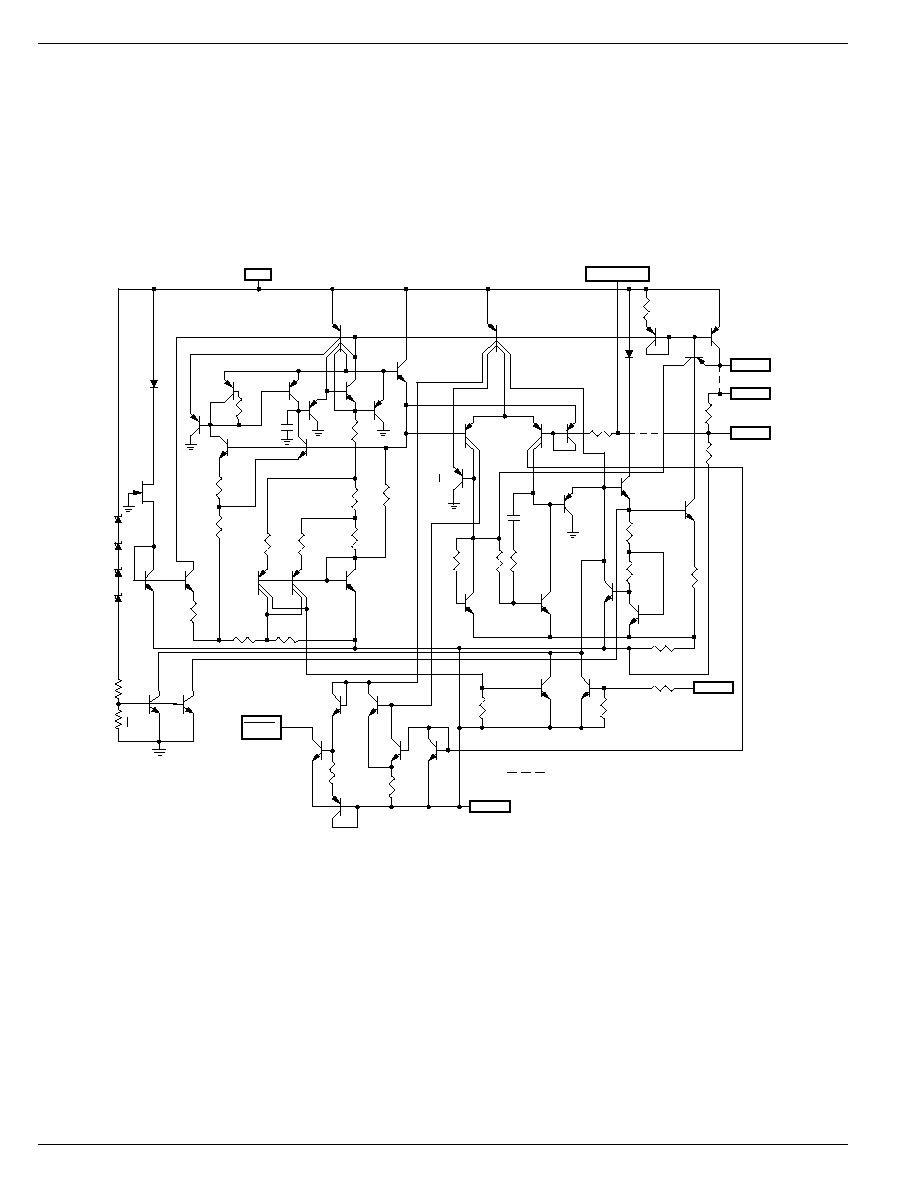
LP2950/2951
Micrel
3-48
February 1999
FEEDBACK
SENSE
Q15A
OUT
Q24
Q26
R27
182 k
5V TAP
R28
60 k
R18
20k
Q25
Q23
Q22
R15
100 k
R16
30 k
Q29
Q28
R17
10
R21 8
R17
12 k
Q31
Q30
R23 60 k
SHDN
R24
50 k
R22
150 k
Q21
Q19
C2
40 pF
R14
350
k
Q14
R13
100
k
Q18
R12
110
k
Q20
Q9
Q15B
Q8
Q7
R11
20.6
k
Q5
R8
31.4 k
R10
150
k
R9
27.8 k
Q11
Q12
Q13
R6
140
k
R5
180
k
R4
13 k
R3
50 k
Q2
C1
20
pF
Q4
Q3
R11
18
k
Q6
Q1
10
R1
20 k
R2
50 k
Q41
R30
30
k
Q40
Q34
GND
Q36
Q37
R25
2.8 k
Q38
ERROR
R26
60 k
Q39
DENOTES CONNECTION ON LP2950 ONLY
Q42
Q16
Q17
50 k
10 k
IN













